© Borgis - New Medicine 2/2008, s. 36-39
*Wojciech Janusz Baranowski, Krzysztof Szymański
Microscopic observation of crystallization of gastric mucins in the presence of Na and K ions
Laboratorium Analiz Śladowych Pierwiastków
Wyższa Szkoła Zawodowa Łódzkiej Korporacji Oświatowej w Łodzi
Summary
Aim: Digestion depends on chemical reactions and physical interactions that take place between food components and hydrolyzed mucins. The aim of the experiment was to show a physical interaction of hydrolyzed gastric mucins with Na+ and K+ depending on the value of pH in the medium.
Materials and methods: To carry out the research an aqueous solution of mucin (type II, crude) from porcine stomach was used (2 mg/50 cm3) and 0.1 M NaCl, KCl, HCl, NaOH and KOH. A drop of water was placed on each of the six basic glasses and next to it there was also placed a drop of the solution: 1. NaCl, 2. KCL, 3. HCl, 4. NaOH, 5. KOH and 6. mucin, respectively. On an additional five glasses a drop of the mucin solution was placed and next to it a drop of the solution: 7. NaCl, 8. KCl, 9. HCl, 10. NaOH and 11. KOH, respectively. These drops were mixed by moving each glass and placing it in the laminar chamber to dry out (4 hours at the temperature of 294 K). The dry spots were observed under the microscope to register the pictures.
Results: Mucin crystals obtained from the neutral water solution are shapeless whereas mucin crystals obtained from the solutions of NaCl, KCl, HCl, NaOH and KOH arrange in clear structures. The crystal habit in each solution differs.
Conclusion: Products of mucin hydrolysis have a dipolar character and combine in a way determined by the electrostatic processes. Mucins of the stomach mucus react to changes in the medium and react with its constituents.
Introduction
The volume and structure of mucin molecules and the variety of the intramolecular chemical bonds affect their physical and chemical properties and especially the chemical activity (1-5). The digestion process depends on chemical reactions and physical interactions that take place between food components and hydrolyzed mucins. Previously it was proved that the chemical properties of the stomach mucins in aqueous solutions change depending on the degree of their hydrolysis and this hydrolysis is reversible (6). It was also revealed that mucins take part in ion exchange processes (7-9).
Aim
The aim of the experiment was to show the physical interaction of the hydrolyzed mucins with the ions Na+ and K+ depending on the value of pH in the medium.
Materials and methods
To carry out the research a water solution of mucin (type II, crude) from porcine stomach was used (2 mg/50 cm3) and 0.1 M NaCl, KCl, HCl, NaOH and KOH. A drop of water was placed on each of the six basic glasses and next to it there was also placed a drop of the solution: 1. NaCl, 2. KCL, 3. HCl, 4. NaOH, 5. KOH and 6. mucin, respectively. On an additional five glasses a drop of the mucin solution was placed and next to it a drop of the solution: 7. NaCl, 8. KCl, 9. HCl, 10. NaOH and 11. KOH, respectively. These drops were mixed delicately by moving each glass and placed in the laminar chamber to dry out (4 hours at the temperature of 294 K). The dry spots were observed under the microscope to register the pictures.
Results
Mucin crystals obtained from the neutral water solution are shapeless (fig. 1 a) whereas mucin crystals obtained from the solutions of NaCl, KCl, HCl, NaOH and KOH arrange in clear structures (Fig. 1 b, 2 b, 3 b, 4 b, 5 b). The crystal habit in each solution differs.
Discussion
Proteids, which means complex proteins, are responsible for physicochemical properties of mucus. In animal mucus these are mainly glycoproteins that are proteins conjugated with carbohydrates. Glycoproteins in which molecular contents of carbohydrates amount to 4% are usually called mucins. Some of them reach the molecular weight of 106 Da and the content of carbohydrates in the mucins can reach even 85% of their weight. In water the mucins form colloidal solutions of real solution character. The size and structure of the mucin molecules, as well as the variety of intramolecular chemical bonds, affect their physical and chemical properties and especially chemical activity (1-4). In the experiment that was carried out it was shown that the mucins of the stomach mucus react to changes in the medium. Mucin crystals obtained from neutral water solution are shapeless and spread chaotically on the surface of the basic glass (fig. 1 a), whereas mucin crystals obtained from the hydrochloric solution arrange in clear compositions (fig. 1 b). The shape and size of the forming structures are not reproducible. It seems that the phenomenon depends on the mucin hydrolysis with formation of molecules of a dipolar character (4, 5). Concentrating the mucin solution by evaporating water leads to formation of mucin molecules as a result of agglutination of the products of mucin hydrolysis. The presence of H+ and Cl- ions when concentrating the solution changes the electrostatic interaction of dipoles in the medium, which prevents reproduction of shapeless structure of the mucin molecules.
In both cases the dipoles form chains and their position on the plane results from the electrostatic interaction in the solution among those chains. The lack of reproducibility of the shape and size of the compositions formed in that way signifies an incidental order of dipole connections. In the neutral solution the chains formed may easily agglutinate, whereas the presence of H+ and Cl- ions prevents agglutination. The fact that chemically unbound HCl is emitted into the atmosphere when drying is an obstacle to observing mucins dissolved in HCl solution. This obstacle disappears when mucins are observed in solutions of salts and hydroxides. As it turned out also in the presence of salt and hydroxides crystals of a unique habit (fig. 2-5) are formed. This means that products of hydrolysis of the mucin react to NaCl, KCl, NaOH and KOH in a similar way as to HCl. In other words mucins not only react to changes in the medium but also react with its constituents.
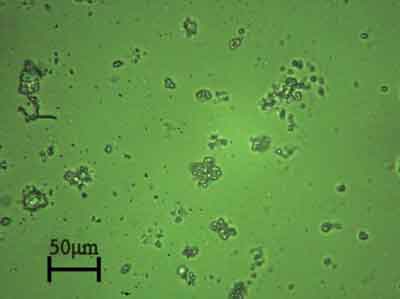
Fig. 1 a. Mucin crystals.
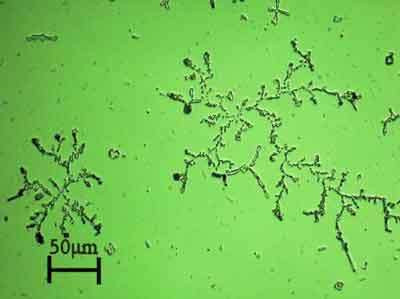
Fig. 1 b. Mucin crystals in the presence of HCl.
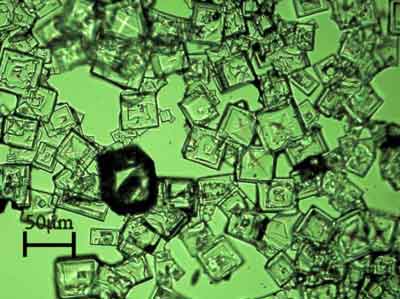
Fig. 2 a. NaCl crystals.
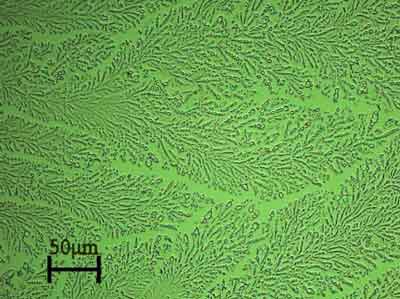
Fig. 2 b. Crystals of NaCl bound with mucins.
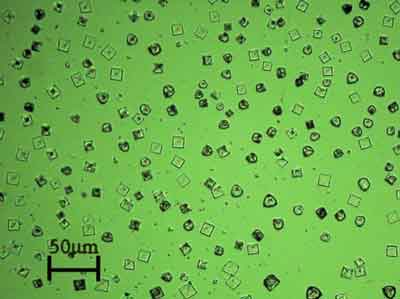
Fig. 3 a. KCl crystals.
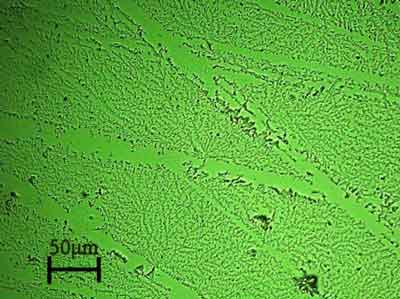
Fig. 3 b. Crystals of KCl bound with mucins.
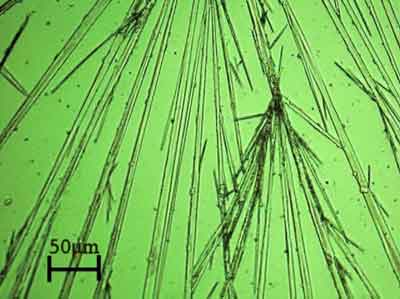
Fig. 4 a. NaOH crystals.
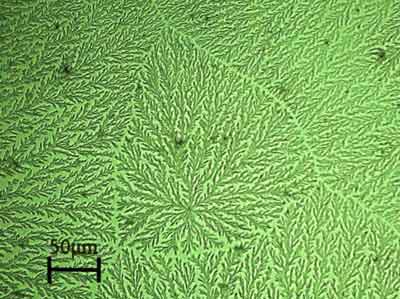
Fig. 4 b. Crystals of NaOH bound with mucins.
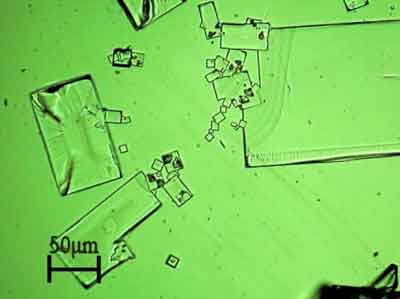
Fig. 5 a. KOH crystals.
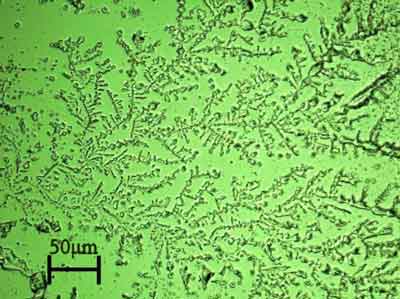
Fig. 5 b. Crystals of KOH bound with mucins.
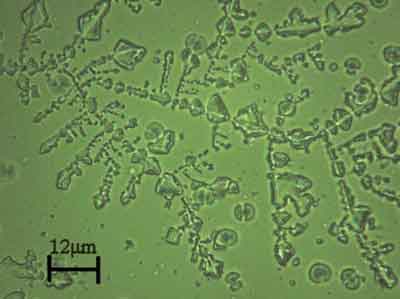
Fig. 6 a. A phenomenon of getting mucins occluded by KOH.
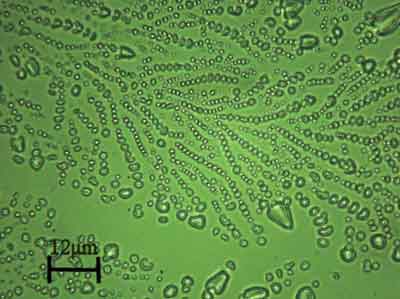
Fig. 6 b. A phenomenon of getting mucins occluded by NaCl.
Borders clearly marked between crystallized structures suggest that formation of the particular structures is a result of electrostatic interactions between electrically neutral molecules and an electric charge diversely arranged. The described phenomenon proves that ions contained in the solution are gathered on the mucins, which stabilizes the colloidal system by producing an electrostatic field, which prevents agglutination of the mucin molecules – in the solution there appear electrostatic microspheres. Ions that are in the microspheres and products of the mucin hydrolysis during water evaporation form systems of unconnected crystals, which are presented in Fig. 6. This phenomenon shows that the products of mucin hydrolysis have a dipolar character and combine only in a way determined by the electrostatic processes.
The described properties of the stomach mucins determine the properties of the stomach mucus and may have significant importance in explaining chemical and physical processes engaged in food digestion as well as in absorption of medicines from the digestive tract. The crystal shapes depend on the packing of the hydrolyzed mucins, during the crystallization, which is related to the intrinsic properties of a protein.
Conclusions
Products of mucin hydrolysis have a dipolar character and combine in a way determined by the electrostatic interactions. Mucins of the stomach mucus react to changes in the medium and react with its constituents. Effects of restated experience suggest that mucins participate in food digestion. Its role depends on delivering a charge which causes breaking of intramolecular bonds in macromolecules of food components. In this way macromolecules disintegrate into easy-to-absorb nutrients.
Piśmiennictwo
1. Cao X, Bansil R, Bhaskar KR, et al.: pH-dependent conformational change of gastric mucin leads to sol-gel transition. Biophys J 1999; 76: 1250-8. 2. Maleki A, Lafitte G, Kjřniksen AL, et al.: Effect of pH on the association behavior in aqueous solutions of pig gastric mucin. Carbohydr Res 2008; 343: 328-40. 3. Shrivastava HY, Nair BU: Structural modification and aggregation of mucin by chromium (III) complexes. J Biomol Struct Dyn 2003; 20: 575-87. 4. Deacon MP, McGurk S, Roberts CJ, et al.: Atomic force microscopy of gastric mucin and chitosan mucoadhesive systems. Biochem J 2000; 348: 557-63. 5. Lori JA, Nok AJ: Mechanism of adsorption of mucin to titanium in vitro. Biomed Mater Eng 2004; 14: 557-63. 6. Baranowski WJ: UV-VIS spectra of intestinal mucins with change in solution concentration and pH. Adv Clin Exp Med 2006; 15: 253-258. 7. Baranowski WJ: Wydzielanie kwasu solnego w żołądku - nowe fakty. Wiad Lek 2007; 60: 405-408. 8. Baranowski WJ: Mucyny żołądkowe są źródłem kwasu. Clin Exp Med Lett 2007; 48: 61-63. 9. Forlong C, Tasman-Jones C, Thomsen L, et al.: The Na+/H+ exchange and H+ diffusion properties of human postmortem mucus: a comparison of gastric antral, gastric body, jejunal and ileal mucus. J Clin Gastroenterol 1990; 12: S110-5.











